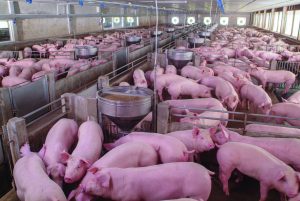R.F.D. NEWS & VIEWS: USDA lauds climate-smart ag opportunities
By Tim Alexander for Chronicle Media — May 26, 2021
A joint study commissioned by Illinois’ pork and soybean associations is examining which soybean varieties provide the most nutritious livestock feed.
In this week’s news digest for Illinois farmers and rural dwellers, we focus on the emerging ecosystems markets available for producers willing to implement new, voluntary soil and water conservation practices on their lands. We also have a report on a feed value study underway that seeks to target the most nutritious soybean varieties for livestock meal. Please read on …
ISAP announces summer eco-market series
SPRINGFIELD — “Farming for the Future” is the theme of a free, four-part webinar exploring new management options and financial opportunities in the fledgling ecosystem market for agriculture. The web series, sponsored by the Illinois Sustainable Ag Partnership and organizations from four other midwestern states, aims to provide farmers and advisers with practical and straightforward information on innovative incentives new to farmers. Webinar segments will offer information and interaction from input providers and market representatives.
The series begins June 22 with a segment on programs available from input buyers Bayer, Corteva and Nutrien, and continues June 24 with market and data platforms available from CIBO, Farmers Business Network and Land O’ Lakes. A July 13 segment will examine packaged goods market opportunities, before the series concludes on July 15 with the focus on water quality markets and additional potential revenue streams for ecosystem services.
More information and registration is available at: www.ilsustainableag.org/ecomarkets.
USDA lauds climate-smart ag opportunities
WASHINGTON, D.C. — The emerging ecosystem market available to agricultural producers is a top agenda item for the Joe Biden White House and U.S. Department of Agriculture. On May 21, the USDA published a 90-day progress report on climate-smart agriculture and forestry, an important step forward in Biden’s executive order on tackling the climate crisis. In a summary of the report, Ag Secretary Tom Vilsack said that with the right tools and partnerships, farmers and foresters could “lead the world” in efforts to increase climate resilience and sequester carbon in soils.
“At this pivotal time, President Biden has called upon USDA to develop a strategy for climate smart agriculture and forestry as part of a whole-of-government effort to address the climate crisis. Central to USDA’s approach is the concept that to be effective, whatever we do must work for farmers, ranchers, and landowners,” Vilsack stated. “Through research, conservation practices and partnerships, USDA aims to find solutions to agricultural challenges, enhance economic growth and create new streams of income for farmers, ranchers, producers and private foresters.”
In his Jan. 27 executive order, Biden highlighted agriculture’s important role in combating the climate crisis by reducing greenhouse gas emissions, sequestering carbon and sourcing sustainable bioproducts and fuels. (USDA news)
FJF: Farmers can fight climate change
WASHINGTON, D.C. — Also on May 20, the Farm Journal Foundation issued the results of a newly commissioned report that determined U.S. farmers have the potential to significantly reduce their greenhouse gas emissions and join the global solution to the climate crisis. The report noted that while U.S. farm operations produce only around 10 percent of national GHG emissions, that percentage could be greatly reduced with the right government incentives in place — such as tax breaks, cost sharing, technical assistance and favorable loan terms.
Otherwise, said Dr. John Reilly of MIT’s joint program on the science and policy of global change, the sustainable investments farmers would make in new conservation programs would fail to make financial sense.
“Farmers are already feeling the effects of climate change, with U.S. growing areas experiencing a series of droughts, floods, and other extreme weather events in recent years,” Reilly said. “These conditions are only expected to intensify. The U.S. should develop and expand programs that help farmers prepare for the challenges that lie ahead, and enable them to make investments to mitigate future climate change.”
Expansion of existing plans, such as USDA-NRCS’ EQIP and CSP programs, would enable more farmers to participate in efforts to help the industry become carbon-positive, according to the FJF report.
Pig, soy farmers to study feed value
SPRINGFIELD — Livestock producers know that certain varieties of soybeans make for better, more nutritious animal feed than do others. Now, a joint study between the Illinois Soybean Association and Illinois Pork Producers Association is analyzing soybean variety selection in order to determine which strains produce the best meal.
“Improving soybean quality is essential if we are going to continue meeting the unique needs of pork producers, and to maintain and grow soybeans’ share in critical livestock feed markets,” says Brock Willard, an ISA director who raises both soybeans and pigs in Pittsfield. “This collaboration between the two associations is a win-win for both soybean and pork producers, and it should have a positive impact on the balance sheets for both groups.”
According to a joint news release, the project will increase the ability to reach both soybean farmers and pig producers with information they need to increase soybean quality, improve soybean industry revenue and maintain pig production performance and producer profitability. Objectives for the program include increasing both the bushel value and feed value of Illinois-grown soybeans, while demonstrating how and why soybean quality and feed value are declining. The study will also highlight how soybeans are being replaced by synthetic alternatives that reduce gross farm income and impact swine health, along with positioning high-quality soybeans as the solution to reversing farm income losses while maximizing pork industry success. (ISA, IPPA news)
Illinois crops are booming
SPRINGFIELD — The Illinois corn crop is 86 percent planted, according to the May 17, 2021 USDA-NASS Illinois Crop Progress and Condition report. This is 15 percent above the five-year average. The soybean crop is 71 percent planted, which is 31 percent above the average.
Illinois Farm Fact:
Checkoff-funded research has determined that half of the soybean varieties available today offer higher feed value than the rest. (Illinois Soybean Association)







